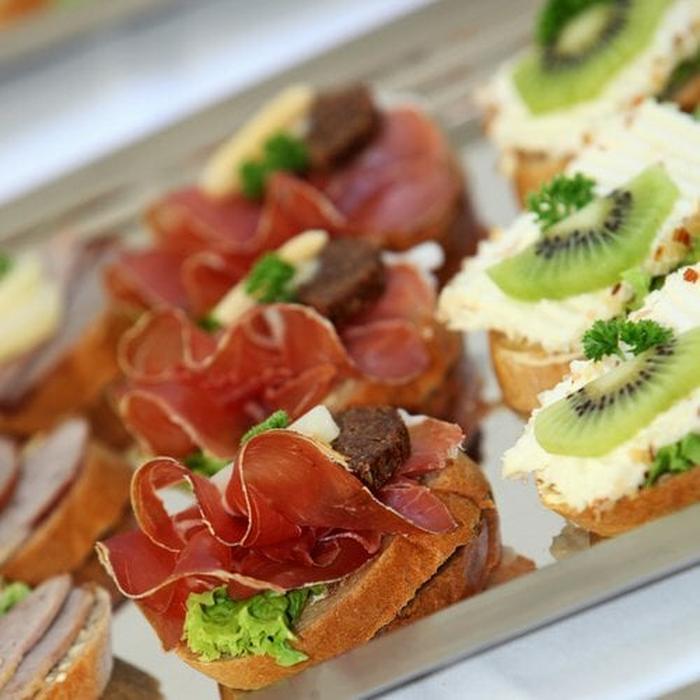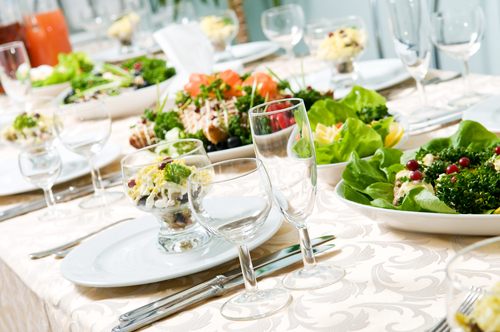
Fall is officially here, which means the holidays are just around the corner. It also means that many of us are about to be tasked with planning the department or office holiday party!
Even if you’ve picked a great restaurant or caterer, one of the toughest parts of the planning process is picking the menu. With so many options, what should you choose? And how do you make sure your choices will be crowd-pleasers?
If you’re feeling a little overwhelmed by all the options, don't worry—just follow these tips for selecting a menu. Your guests will be eating out of the palm of your hand.
Cocktail Party
The Scene
Whether you’re planning a holiday cocktail party, keep it on the up and up. It doesn’t have to be stuffy, or even fancy, but when people get an invite to a cocktail party, they expect a high-end affair. Your menu should follow suit.
The Set Up
Cocktail parties call for hors d’oeuvres, passed or plated. I suggest both: Have a food station set up in advance so guests have something to nosh on as soon as they arrive, then begin serving the passed appetizers as soon as the flow of guests increases.
The Selection
The key to making your party feel unique from every other cocktail party you’ve been to is to incorporate a theme into your menu. If you’re throwing a holiday soirée and there are cranberry cheese puffs on the menu, serve them. If there isn’t a distinct theme to your party, just think seasonal. For fall or winter events, warm appetizers like mini beef wellingtons or baked brie are perfect. Use the buffet station for finger foods that are more difficult to pass, such as artisan cheese platters, charcuterie plates, or upscale vegetable crudités.
The most important thing to remember is to keep your menu well-rounded so there’s something for everyone. Make sure your passed appetizer selections include at least one meat option, one vegetarian option, and one gluten-free option.
Formal Dinner
The Scene
This is one event where you want to go all out! Whether you’re hosting a few couples at a restaurant or planning a 50-person holiday dinner, people will be anticipating a formal event and a delicious meal.
The Set Up
Formal dinners are generally three courses (soup or salad, entrée, then dessert), often preceded by a cocktail hour. Serve a few small appetizers during the cocktail hour, and then, when guests are seated, begin with the first course.
The Selection
Again, you’ll want to keep the theme and season in mind. In the fall and winter, starting with a butternut squash or pumpkin soup makes more sense than, say, a Caprese salad with summer tomatoes.
The main course, being the star of the show, should be selected carefully. First, consider whether you’ve had a heavy or light starter course. If you’ve served something really rich, like lobster bisque, you may want to go with a lighter main course, and choose something like roasted chicken or fish. If you’ve selected a lighter soup or a salad, it’s appropriate to serve something heavier, like braised short ribs or filet mignon. If you are unsure what to choose, ask your caterer which dishes are customer favorites and go with one of those. For large dinners, make sure to always have a vegetarian selection.
For dessert, see if your restaurant or caterer is offering any seasonal desserts, like pumpkin spice cake or gingerbread butterscotch pudding. If so, serve them! But again, keep in mind the flow of the meal that precedes it. If you have your heart (and taste buds) set on more robust starter and main courses, serve a simple fruit tart or something lighter for dessert.
Luncheon
The Scene
If you’re planning a holiday brunch or luncheon, there are a few things to keep in mind. Though lunches are often three courses, like a formal dinner, they’re generally more casual. Not that the same amount of attention and care shouldn’t go into planning a lunch, but a morning or mid-day party should feel comfortable and easy-going.
The Set Up
Food service for a lunch or brunch can be plated or buffet style. It’s common to have two or three courses (salad, a hot dish, and a dessert, or just a main course and a dessert). Depending on the formality of the affair and the season, decide accordingly.
The Selection
In cooler months, it’s more common to serve salad, a hot dish, and a dessert than in the warmer months, where a heavy salad could serve as a main course. If you’re serving a hot entrée, think fall and winter favorites, like pumpkin sage ravioli or cranberry and goat cheese stuffed chicken breast. Leave the heavier dishes, such as beef bourguignon, where they belong—on the dinner plate. Depending on what you serve for your entrée, choose an alternate vegetarian and gluten-free option for those who need it. When selecting a buffet menu select a chicken, a steak or fish, and a vegetarian entrée.
For brunch, buffet style is best. Order a selection of egg dishes, pastries, sweet entrees, like waffles and French toast, and even an assortment of fresh seafoods and salads. This allows guests to sample as they please.
A final note: If you’re planning a large-scale event, ask your caterer about doing a tasting beforehand. Generally, you can choose two or three options from each course to taste before you make your final menu selection. Not you will not only get to dive into a complimentary and delicious spread, but you’ll avoid serving something that looked better on paper.


